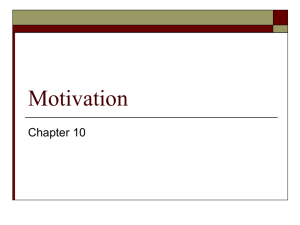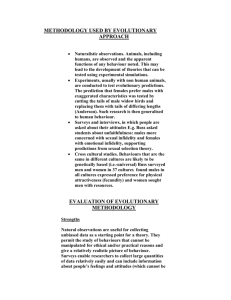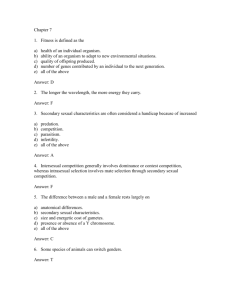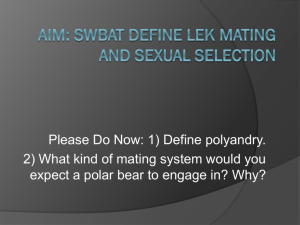Sexual selection exam answers
advertisement
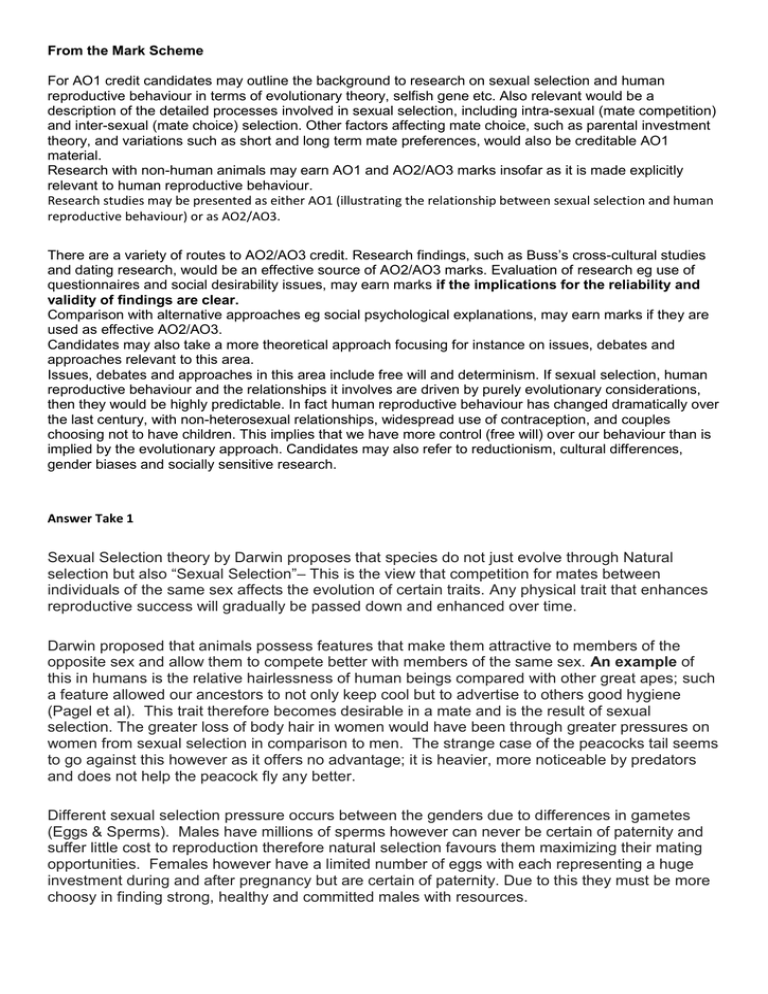
From the Mark Scheme For AO1 credit candidates may outline the background to research on sexual selection and human reproductive behaviour in terms of evolutionary theory, selfish gene etc. Also relevant would be a description of the detailed processes involved in sexual selection, including intra-sexual (mate competition) and inter-sexual (mate choice) selection. Other factors affecting mate choice, such as parental investment theory, and variations such as short and long term mate preferences, would also be creditable AO1 material. Research with non-human animals may earn AO1 and AO2/AO3 marks insofar as it is made explicitly relevant to human reproductive behaviour. Research studies may be presented as either AO1 (illustrating the relationship between sexual selection and human reproductive behaviour) or as AO2/AO3. There are a variety of routes to AO2/AO3 credit. Research findings, such as Buss’s cross-cultural studies and dating research, would be an effective source of AO2/AO3 marks. Evaluation of research eg use of questionnaires and social desirability issues, may earn marks if the implications for the reliability and validity of findings are clear. Comparison with alternative approaches eg social psychological explanations, may earn marks if they are used as effective AO2/AO3. Candidates may also take a more theoretical approach focusing for instance on issues, debates and approaches relevant to this area. Issues, debates and approaches in this area include free will and determinism. If sexual selection, human reproductive behaviour and the relationships it involves are driven by purely evolutionary considerations, then they would be highly predictable. In fact human reproductive behaviour has changed dramatically over the last century, with non-heterosexual relationships, widespread use of contraception, and couples choosing not to have children. This implies that we have more control (free will) over our behaviour than is implied by the evolutionary approach. Candidates may also refer to reductionism, cultural differences, gender biases and socially sensitive research. Answer Take 1 Sexual Selection theory by Darwin proposes that species do not just evolve through Natural selection but also “Sexual Selection”– This is the view that competition for mates between individuals of the same sex affects the evolution of certain traits. Any physical trait that enhances reproductive success will gradually be passed down and enhanced over time. Darwin proposed that animals possess features that make them attractive to members of the opposite sex and allow them to compete better with members of the same sex. An example of this in humans is the relative hairlessness of human beings compared with other great apes; such a feature allowed our ancestors to not only keep cool but to advertise to others good hygiene (Pagel et al). This trait therefore becomes desirable in a mate and is the result of sexual selection. The greater loss of body hair in women would have been through greater pressures on women from sexual selection in comparison to men. The strange case of the peacocks tail seems to go against this however as it offers no advantage; it is heavier, more noticeable by predators and does not help the peacock fly any better. Different sexual selection pressure occurs between the genders due to differences in gametes (Eggs & Sperms). Males have millions of sperms however can never be certain of paternity and suffer little cost to reproduction therefore natural selection favours them maximizing their mating opportunities. Females however have a limited number of eggs with each representing a huge investment during and after pregnancy but are certain of paternity. Due to this they must be more choosy in finding strong, healthy and committed males with resources. There are then two types of sexual selection that take place in relation to human reproductive behaviour: Intra-sexual selection in males and Intersexual selection in females. Intra-sexual selection occurs in males who compete with each other for access to females. As a consequence of this men for example have evolved indicators such as strong jaw lines, high cheekbones triangular backs and wide shoulders as these are signs of strength and testosterone which women will seek. High levels of testosterone can damage immune systems how- ever and they would only be able to be displayed in strong males (Handicap principle). Thornhill et al also found that women tended to prefer men with such traits suggesting these are indicators within sexual selection theory for humans. Men on the other hand look for signs of fertility through youth and physical attraction as this maximizes reproductive success for them. Intersexual selection occurs between women who then go on to select men who show the best indicators of providing good genes for offspring, the ability to protect her and her child, provide status and resources. Psychologists propose it is this evolutionary behaviour that then shapes mate selection in males and females. Males should in theory look for females showing signs of fertility, youth and physical attraction and females should seek males showing signs of genetic strength, masculine features and the ability to provide and protect. Can you work out what’s missing from this essay? Take 2 Darwin suggests that sexual selection is more important than natural selection in shaping human reproductive behaviour. An example of sexual selection operating over time is the relative hairlessness of human beings compared to other apes. Pagel and Bodmer (2003) claim that this is because hairlessness allowed humans to ‘advertise’ their reduced susceptibility to infection, this trait therefore became desirable in a mate (a consequence of sexual selection). There are two types of sexual selection: intrasexual and intersexual. Where conditions favour polygyny, males must compete with other males for access to a female mate. This is intrasexual selection (selection within the same sex). In contrast, females who invest heavily in their offspring need to make the right choice in a mate and can afford to be choosy and engage in intersexual selection (selection between the sexes). Thus, males compete and females choose. Intersexual selection involves preference for a member of the opposite sex who possesses certain qualities; to compensate for this, humans have developed certain characteristics to improve their chances of reproduction and ultimately, survival. For example, human facial attractiveness is linked to the advertisement of ‘good genes’. Thus, individuals possessing attractive facial features are preferred as mates because of the benefit of passing on these attractive genes. Buss (1989) investigated the sex differences in human mate preferences across 37 cultures. By using questionnaires to measure the importance of factors affecting mate choice, he found that women from all cultures showed a preference for men with resources. Men universally preferred physically attractive and younger women, and some characteristics (intelligence and kindness) were desired universally by both sexes. However, a major flaw of Buss’s (1989) investigation is in the methodology. Buss used questionnaires to assess the importance of factors affecting mate choice. It is likely that people gave social desirable answers to prevent themselves from being judged, compromising the validity of the study. Furthermore, although a large sample size was used, it is not a representative sample as people living in rural areas and less educated individuals were underrepresented. The sampling method also differed across cultures, affecting the reliability of the findings as variables were not controlled. Another weakness of the research documenting sex differences in mate choice is that focus is usually drawn to preference, as opposed to real-life choices. While people may express a preference, they often have to settle for less. On the other hand, a strength is that there is evidence for evolutionary influences on facial preferences. Interest in attractive female faces emerges early in the first year of infancy, this implies that the preference for attractive faces is likely to be an evolved response (Langlois et al. 1987). Furthermore, research support for facial preferences comes from Penton-Voak et al. (1999). They found that women’s preferences for attractive faces are not static. Women are attracted to masculine-looking men during their fertile time and show a preference for feminine-looking men during less fertile times. This may indicate that less-masculine looking men may make better long term partners, but masculine-looking men produce the strongest, healthiest children. In evaluating Darwin’s explanation of the relationship between sexual selection and human reproductive behaviour, it is important to point out that it does not account for homosexual relationships which do not contribute to reproductive success and the passing of genes. Due to this heterosexual bias, we cannot generalise this explanation to all relationships. Another weakness is the overemphasis placed on evolutionary factors. Nicolson (1999) suggests that choosing a mate is likely to be based on a whole range of issues, not simply evolutionary influences. We can therefore argue that Darwin’s explanation is too simplistic and reductionist as it fails to account for other possible influences such as social norms. It can also be argued that evolutionary explanations are determinist. This view suggests that we are victims of evolution and driven by the need to reproduce and pass on good genes to our offspring. According to this view, we would mate with someone who is physically attractive. However, this ignores the role of free will. Rather there are other possible factors for choosing a mate, such as personality. Sex differences in reproductive behaviour can also be explained by an alternative perspective. For example, the behavioural model would suggest that social learning theory has a major role in shaping human reproductive behaviour. The media, for instance, often portrays males as sexually promiscuous, thus it is likely this behaviour is imitated. Take 3 Intrasexual selection is the evolutionary process by which members of one sex (usually males) compete with each other for members of the opposite sex. The victors are able to pass on their genes while the losers are not. The factor that made the male successful is then passed on to the offspring, helping to ensure their survival and the passing on of their genes. Intersexual selection refers to the fact that members of each sex have innate preferences for mates with certain characteristics. The preferences of one sex determine the areas in which the other sex must compete (e.g. physical attractiveness for women). These indicators reveal traits which could be passed on to offspring (e.g. height) or which could give protection & support to the offspring (e.g. economic resources). Men have a greater desire for casual sex & tend to seek sex earlier in the relationship. This is because men can produce several children within a year, while women cannot: men have an evolutionary desire to impregnate a woman as soon as they can before moving on. Men experience a decrease in sexual attraction following sex to prevent them from spending too much time with any one woman. For long-term mating, both sexes must invest heavily in any offspring. Choosiness is therefore high in both sexes, as they wouldn't want to waste valuable resources if their mate is providing poor genes or little child-rearing support. Women are particularly choosy, as have to make an obligatory biological investment in the child. Females thus look for good resources, physical strength, etc. Buss explored what males & females look in a marriage partner for 10,000+ folks from 37 cultures. The results supported predictions of evolutionary explanations of sexual selection. For example, women want good financial prospects: men with financial resources to provide for children. Men want physical attractiveness, which research has consistently confirmed to be linked av fertility & health. Men also wanted younger women: an indication of fertility. Studies such as Buss' may suffer from a validity problem, as although they provide information about expressed mate choices, this may be different to info about actual mate choice (in which compromises are made). However, another study by Buss of actual married couples from 29 cultures supported the original results. For example, men do marry younger women. Although Buss' study supports the idea that men prefer younger women, this may not be because of fertility. Some critics have tried to explain this in terms of social power: younger women are easier to control and are therefore preferable as mates. Kenrick et al. rejected this hypothesis by finding that teenage males are most attracted to women 5 years older than them: these women are not easily controlled. Evolutionary explanations of sexual selection have faced some scepticism as being choosy about sexual partners can be costly, as it requires time and energy, and would result in the creation of less children than if we were to mate with any available partner. These disadvantages of being choosy are real, but they do not outweigh the advantages of being choosy: choosiness allows the production of high-quality offspring whose genes are much more likely to be passed on. The claim that males are more likely than females to seek short-term mating opportunities is supported by research. Clarke & Hatfield found that 75% of males were willing to have sex with an attractive stranger, but no females were. This suggests that males have evolved such mechanisms to increase reproductive success. Research suggests that female mate choice varies across the menstrual cycle. Penton-Voak et al. found that females preferred more masculine faces during more fertile phases & more feminine faces during less fertile phases. This suggests that females may choose a partner whose feminine features suggest kindness & cooperation in childrearing, but mate with a male who possesses desirable qualities in offspring. Visual & chemical indicators can tell men when women are at their most fertile stage in the menstrual cycle. According to evolutionary explanations, men would find women most attractive at these times. Miller et al. analysed tips earned by lap dancers. They earned almost twice as much money in these phases, showing that men are most attracted to women when in the most fertile phase of the menstrual cycle. There may be a gender bias in research on short-term mating. Although short-term mating can be costly to females, they could also profit from it. They may use short-term mating as a way of ending a relationship with a poor-quality male or as a way of producing more genetically diverse offspring. Take 4 Human reproductive behaviour is an evolutionary approach; it tries to explain human behaviour from the point of view of how it might have evolved. It is based on the idea that our behaviour is influenced by instincts left over from our evolutionary past when they were adaptive, so increasing our chances of survival. Sexual selection is the process in which a species changes over time as a result of the passing on of the genes that make one individual more attractive than another. This happens because members of the same species compete with other members of the same sex for a mate. The members who have features that make them more attractive are more likely to reproduce and pass on their genes. This theory is important in explaining why males and females of some species look so different, for example, male and female peacocks because the males have long brightly coloured tails which reduce chances of survival with predators however as female peacocks are attracted to this feature, it shows that males with better tails have more chance of reproducing and passing on their genes therefore the characteristic evolves in the species even though it reduced survival. There are two types of sexual selection, intrasexual selection (mate competition) and intersexual (mate choice). Intrasexual selection is when member of one sex (usually males) compete with each other for access to members of the opposite sex. The victors are able to make and pass on their genes, whereas the losers do not. Whatever trait leads to success in these same sex contests will be passed on to the next generation. Intersexual is a form of selection which involves the preferences of one sex for members of the opposite sex who possess certain qualities, for example, if females prefer tall men, over time there would be an increase in the number of tall males in the population. The preference of one sex determines the areas in which the other sex must compete. This may be in terms of plumage (in peacock) or economic resources (in humans). Ridley pointed out that in the past 100,000 years the human species has hardly evolved at all and therefore our psychology is very much as it would have been when we were all hunter gatherers. He believed that men are driven to behave in ways that will maximize the probability that they will reproduce. (Gain resources, gain power, lure women, mate with as many women as possible etc.) Where as women are driven by the desire to secure the best genes possible for their children and to be protected by a powerful man in order to maximize the chances of their children surviving. Thornhill and Palmer went further and proposed that rape has evolved as a mechanism to allow unsuccessful men to reproduce. This theory has proved highly controversial. Rose and Rose believe that this amounts to justifying rape ad a good this for a species. Buss aimed to test the hypothesis that the factors affecting mate choice in men and women are consistent across a range of cultures and therefore demonstrating the role of evolutionary factors. Buss used questionnaires to measure the importance of factors affecting mate choice. He found that 36/37 cultures women emphasized good financial prospects in a mate than did men and in 29/37 cultures women placed significantly more emphasis on ambition and industriousness than did men. This is in line with evolutionary theory as they are trying to secure a mate with good resources to care for them and their children. In all 37 cultures men rated ideal age of a mate as younger than did women and looks were more important in men than women in all 37 cultures. This is because youth and attractiveness signifies fertility. Therefore most findings supported the idea that men and women differ consistently in the characteristics they find attractive in a potential mate. This shows evidence of intersexual selection as males and females look for different things in a potential mate. However there are many strengths and weaknesses. For example in the case of homosexuality, Buss’s argument cannot account for homosexual relationships which clearly do not contribute to the survival of the species. Same sex relationships seem to have existed in most cultures throughout recorded history, so explanation for sexual selection cannot explain these relationships, therefore it cannot be generalised to all relationships. A second weakness related to mate choice in real life. Buss’s survey of mate choice suffers from a serious problem of validity. The research has focused on preferences rather than on real life choices. For example, people may express a preference for an ideal partner (intelligent, kind etc.) but may have to settle for less. This therefore means that the study does not tell us about actual mate choice. However a study of real life marriages has conformed many of these predictions, such as, men do choose younger women (Buss). One major flaw of this study is in the methodology. Although a large sample size was used, Buss did not use a representative sample. In his study people living in rural areas were underrepresented as were those individuals who were less educated as the study relied on people completing a questionnaire. The sampling method created another problem as is varied widely across cultures and he used opportunity and selfselecting samples, both of which are not random and could introduce sampling bias. However there is research evidence to support Buss’s ideas. Schmitt tested the idea of sex differences in mating preferences and surveyed over 16000 people from 53 countries. Schmitt found that men reported wanting to have sex with more people than women did, supporting the idea of sex differences in human reproductive behaviour. Another sex difference is facial preferences. Facial preferences can also play an important role when choosing a mate. The evolutionary view is that human facial attractiveness is liked to good genes. Research has shown that females are attracted to male’s faces that have “masculine” features such as large jaw and prominent cheek bones. These characteristics are seen as a result of the testosterone, but the hormone may also become a handicap because it is also know to supplement the immune system. This means that only “healthy” individuals can afford to produce these masculine traits indicating their dominance and strength of their immune system to women who are then more likely to select them as possible mates. (Thornhill and Gangestad). Males also have clear facial preferences, preferring females with more child like faces, including large eyes, small noses and full lips. These characteristics indicate youth and fertility, making them more attractive as potential mates (Thornhill and Gangestad). Interest in attractive female faces emerges early in the first year of infancy this implies that the preference is more likely to be an evolved response rather than a learned behaviour. There is also a significant degree of cross cultural agreement in rating of attractiveness (Perrett). This shows that the criteria for facial attraction is not determined by cultural conventions. Intersexual selection has been discussed in Buss’s research but there are also consequences for intrasexual selection. Sperm competition is a type of intrasexual competition and it is important in determining which male is successful in fertilising her egg. This perspective suggests competition for fertilisation not females. This has resulted in males evolving larger penises, larger testicles, larger ejaculates and faster swimming sperm. Harvey and May suggested that ethnic difference in testicle size may reflect adaptive differences in mating strategies within different populations. Measurements made during autopsy showed that testicle size in two Chinese samples was approx half the size of testicles in a Danish sample. This could be due to the norm of arranged marriages in Chinese culture and therefore a reduction in sperm competition as they will have a sexual relationship with one partner. One evaluation point is the fact that some psychologists argue that evolutionary psychology is not the answer to everything, Nicolson argues that the relevance of evolutionary factors has been overemphasised; she argues that this is not how people really live and choose partners and decisions are more likely to be made on a whole range of issues. She suggested that evolutionary influences on human reproductive behaviour are lost in today’s social context. This therefore suggests that evolutionary explanations are reductionist as they are too simplistic and focus on innate instincts and ignore another other important contributory factory. This approach ignores the role of social or cognitive factors. It could also be argued that evolutionary explanations are deterministic. It assumes that all men will be motivated to have a high number of sexual partners and be less inclined towards a long term committed relationship and that all women are motivated by the resources a male has to offer. This ignores the role of free will and choice that both males and females have in deciding what relationships they want. There are cases of males that settle down with one person at an early age and women who do not decide to settle down and have children. Sex differences in reproductive behavior could also be explained by an alternative perspective. It could be argued using the social approach that the idea that men are motivated to sleep around is something that is created and reinforced by society and socialization. Behavioural approaches would also explain this via the role of the media. The media could have a role via social learning theory as there are many social models in the media where males are exposed to this behaviour. Sexually promiscuous behavior is also celebrated by the male peer group and this could be an alternative reason for this sex difference. There are loads more on the inter net – which one do you like best? Can you see common themes and styles in these essays?


